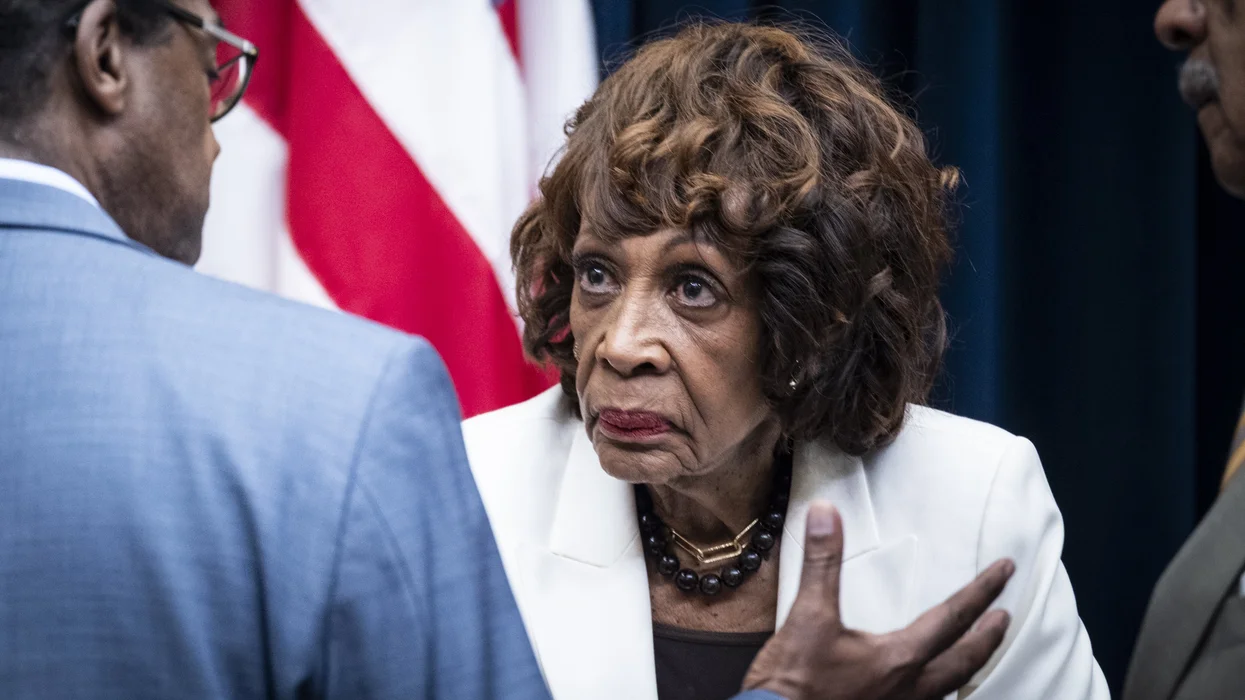WASHINGTON (TheBlaze/AP) -- Americans will probably know who their next president is on Tuesday night or early Wednesday, but the formal process for picking a president actually extends beyond then (and, it's more complicated than meets the eye).
The system we're speaking about, of course, is the ever-elusive Electoral College. Before we delve into the specifics of how it works, let's take a trip down memory lane. After all, it's difficult to understand the system if one knows little about its history and the original intentions behind its formulation.
HERE'S THE HISTORY OF THE ELECTORAL COLLEGE
As most Americans know, the Electoral College has the ultimate say when it comes to deciding the fate of presidential face-offs. Barring recounts or a tie between Democrat Barack Obama and Republican Mitt Romney, the exercise that is undertaken is largely academic -- one that many Americans may not fully comprehend. The history, much like the Electoral College's operations, is complex.
 Voters cast their ballots November 6, 2012 in Portage, Ohio. Voting is underway in the battleground state of Ohio in the U.S. presidential election between Democratic President Barack Obama and Republican nominee former Massachusetts Gov. Mitt Romney. Credit: Getty Images
Voters cast their ballots November 6, 2012 in Portage, Ohio. Voting is underway in the battleground state of Ohio in the U.S. presidential election between Democratic President Barack Obama and Republican nominee former Massachusetts Gov. Mitt Romney. Credit: Getty Images
The origins of the system date back to the nation's founding. The Founders, looking for a fair method through which to hold presidential elections, weighed the odds and eventually drafted what they saw as an extremely viable framework. History.com has more about how the Electoral College came to fruition:
The Constitutional Convention of 1787 considered several methods of electing the President, including selection by Congress, by the governors of the states, by the state legislatures, by a special group of Members of Congress chosen by lot, and by direct popular election. Late in the convention, the matter was referred to the Committee of Eleven on Postponed Matters, which devised the electoral college system in its original form. This plan, which met with widespread approval by the delegates, was incorporated into the final document with only minor changes. It sought to reconcile differing state and federal interests, provide a degree of popular participation in the election, give the less populous states some additional leverage in the process by providing "senatorial" electors, preserve the presidency as independent of Congress, and generally insulate the election process from political manipulation.
The Constitution gave each state a number of electors equal to the combined total of its membership in the Senate (two to each state, the "senatorial" electors) and its delegation in the House of Representatives (currently ranging from one to 52 Members). The electors are chosen by the states "in such Manner as the Legislature thereof may direct "(U.S. Constitution, Article II, section 1).
As for the purpose, FactCheck.org provides an additional summary of what led to the creation of the Electoral College -- a schema that was apparently viewed by the Founders as a protection against the exploitation of democracy by special interest cohorts:
The reason that the Constitution calls for this extra layer, rather than just providing for the direct election of the president, is that most of the nation’s founders were actually rather afraid of democracy. James Madison worried about what he called "factions," which he defined as groups of citizens who have a common interest in some proposal that would either violate the rights of other citizens or would harm the nation as a whole. Madison’s fear – which Alexis de Tocqueville later dubbed "the tyranny of the majority" – was that a faction could grow to encompass more than 50 percent of the population, at which point it could "sacrifice to its ruling passion or interest both the public good and the rights of other citizens." Madison has a solution for tyranny of the majority: "A republic, by which I mean a government in which the scheme of representation takes place, opens a different prospect, and promises the cure for which we are seeking."
Of course, this is only a brief recap of the framework -- and the system has evolved over time. You can read more about the history over at History.com.
HERE'S HOW IT WORKS
Now that we know a bit about the methods behind the system's creation, we can take a look at how it works in practical terms. Members of the Electoral College, known as electors, meet in in state capitols or other designated spots in mid-December (yes, more than one month after the election takes place).
Each party has slates of electors, but the one aligned with the winner of that state's popular vote is empowered to cast separate ballots for president and vice president. It is typically uneventful, but there have been instances of "faithless" electors where a ballot is cast for someone other than that state's prevailing nominees. The ballots are sent to Washington to be formally counted in the Senate on Jan. 6 (yes, two months after the election), though the results are usually known that day.
 Credit: AFP/Getty Images
Credit: AFP/Getty Images
If Obama and Romney finish the Electoral College process at 269-269 -- or no candidate amasses the needed 270 votes because an alternate candidate scores some votes -- the 12th Amendment comes into play. Under that scenario, the newly sworn U.S. House elects the president and the Senate the vice president.
Each House delegation gets a single vote. Republicans are likely to hold a majority of state delegations after Tuesday, but there could be intrigue in the unlikely event that several delegations wind up evenly split. If the Senate remains in Democratic hands, there is a possibility that the Romney could be president and Democratic Vice President Joe Biden his No. 2 (a fascinating prospect, no?).
NOTABLE ELECTIONS IN U.S. HISTORY
Among the most notable elections was 1824, when Democratic-Republican candidate John Quincy Adams lost the popular vote and was behind in the Electoral College tally but still was chosen as president by the House. There are some other intriguing examples, too, covering elections in which the popular vote winner ended up losing the race in the Electoral College. Here they are:
1876: Republican Rutherford Hayes defeats Samuel Tilden by 185 to 184 in Electoral College despite a 254,235-popular-vote deficit.
1888: Republican Benjamin Harrison defeats Democrat Grover Cleveland by 233 to 168 in Electoral College despite 90,596-popular-vote deficit.
2000: Republican George W. Bush defeats Democrat Al Gore by 277 to 266 in Electoral College despite 543,895-popular-vote deficit.
While the aforementioned examples certainly frustrated some and caused questions to emerge about the Electoral College system, the structure that the nation's Founders put into place continues, though amended, today. On the flip side, over the nation's history there have also been some noteworthy "landslide" victories.
 Credit: AFP/Getty Images
Credit: AFP/Getty Images
Electoral College landslides in presidential elections over the past century, which saw the winner collect at least double the loser's Electoral College votes, have happened on occasion (it's unclear whether today's election will have a similar ending). Here's a list of past electora landslides:
1912: Democrat Woodrow Wilson defeats Progressive Theodore Roosevelt by 2.2 million votes (Republican incumbent William Taft finished third) and wins Electoral College 435 to 88.(asterisk)
1920: Republican Warren G. Harding defeats Democrat James Cox by 7 million votes and wins Electoral College 404 to 127.
1924: Republican incumbent Calvin Coolidge defeats Democrat John Davis by 7.3 million votes and wins Electoral College 382 to 136.(asterisk)
1928: Republican Herbert Hoover defeats Democrat Al Smith by 6.4 million votes and wins Electoral College 444 to 87.
1932: Democrat Franklin Roosevelt defeats Republican incumbent Herbert Hoover by 7.1 million votes and wins Electoral College 472 to 59.
1936: Democratic incumbent Franklin Roosevelt defeats Republican Alf Landon by 11 million votes and wins Electoral College 523 to 8.
1940: Democratic incumbent Franklin Roosevelt defeats Republican Wendell Wilkie by 5 million votes and wins Electoral College 449 to 82.
1944: Democratic incumbent Franklin Roosevelt defeats Republican Thomas Dewey by 3.5 million votes and wins Electoral College 432 to 99.
1952: Republican Dwight Eisenhower defeats Democrat Adlai Stevenson by 6.6 million votes and wins Electoral College 442 to 89.
1956: Republican incumbent Dwight Eisenhower defeats Democrat Adlai Stevenson by 9.6 million votes and wins Electoral College 457 to 73.(asterisk)
1964: Democratic incumbent Lyndon Johnson defeats Republican Barry Goldwater by 15.9 million votes and wins Electoral College 486 to 52.
1972: Republican incumbent Richard Nixon defeats Democrat George McGovern by 18 million votes and wins Electoral College 520 to 17.(asterisk)
1980: Republican Ronald Reagan defeats Democratic incumbent Jimmy Carter by 8.4 million votes and wins Electoral College 489 to 49.
1984: Republican incumbent Ronald Reagan defeats Democrat Walter Mondale by 16.9 million votes and wins Electoral College 525 to 13.
1988: Republican George H.W. Bush defeats Democrat Michael Dukakis by 7.1 million votes and wins Electoral College 426 to 111.
1992: Democrat Bill Clinton defeats Republican incumbent George H.W. Bush by 5.8 million votes and wins Electoral College 370 to 168.
1996: Democratic incumbent Bill Clinton defeats Republican Bob Dole by 7.7 million votes and wins Electoral College 379 to 159.
2008: Democrat Barack Obama defeats Republican John McCain by 9.7 million votes and wins Electoral College 365 to 173.
Regardless of whether Obama or Romney clinches victory this cycle, inauguration day is Jan. 20. For more information about the Electoral College, click here.

 Voters cast their ballots November 6, 2012 in Portage, Ohio. Voting is underway in the battleground state of Ohio in the U.S. presidential election between Democratic President Barack Obama and Republican nominee former Massachusetts Gov. Mitt Romney. Credit: Getty Images
Voters cast their ballots November 6, 2012 in Portage, Ohio. Voting is underway in the battleground state of Ohio in the U.S. presidential election between Democratic President Barack Obama and Republican nominee former Massachusetts Gov. Mitt Romney. Credit: Getty Images





